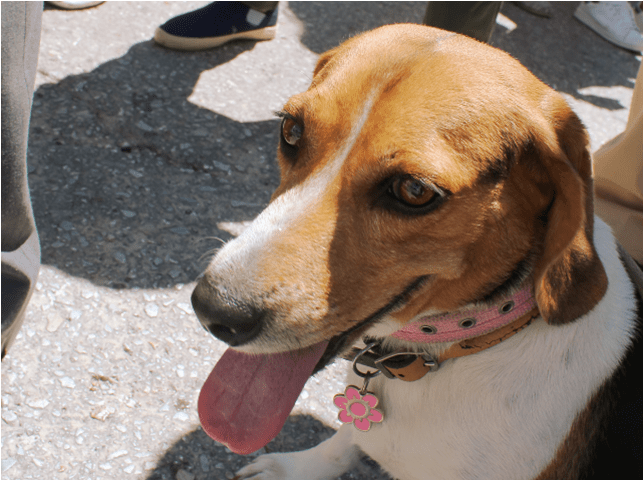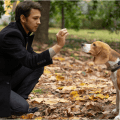Table of Contents
Socializing your Beagle puppy from an early age is essential. Do you know why? Because a dog who is socialized well is not aggressive toward other dogs or people. He knows that other dogs and people exist and are not necessarily threats to his territory. A dog who is not socialized, on the other hand, feels as if the world is his own and he’s the only dog allowed to be in it. He gets angry and threatened when other dogs or people show up. So as soon as you bring your puppy home, you need to start socializing him. Get him used to having other people and dogs in his life.
How to Condition Your Beagle to Get Along with Everyone
Your attitude is very transparent to your Beagle. He can read you like a book. When you are upset with him, he can sense it. He can also sense when you are in a bad mood, and he won’t understand that your bad mood has nothing to do with him.
Therefore, during the process of socialization, you must take care to have a good attitude. Your puppy will bond better if he gets good vibes from you. Always be patient, gentle, encouraging, and loving. Show more pride and happiness than anger or frustration. Positivity is going to be your key to success when training your Beagle. Don’t keep pushing your dog and getting mad or you will ruin the training experience and overall results for both of you.
A huge part of socializing your dog is conditioning him to become the type of dog that you want him to be when he is an adult. Therefore, you want to do the most work during this period and focus on your end goal. (The earlier, the better is the rule of thumb when training) So have a plan, and stick to it, be consistent, know what you expect of him and make it clear. Really get happy and excited when he does what you want and reward him handsomely for desirable behavior. When you follow these principals, you can be amazed at how great you are at training your new Beagle
Another huge part of socializing is forging the special bond that you want to share with your Beagle for the rest of his life. You must do this by teaching him that you are the master. But you also want to teach him that you love him and that you two are best friends. If you take the right approach outlined in this training guide and treat your dog like a best friend from the beginning, he will become the most loyal and loving friend that you have ever had. So approach socializing with the attitude that you want to be friends with this dog, but be sure to also show that you are the dominant friend and the pack leader. Be gentle but firm. Provide direction without being mean or aggressive. Firmness is always better than aggression when socializing A Beagle puppy.
When and How to Socialize A Beagle Puppy
Your Beagle puppy already begins the socialization process when he is just three weeks old. Until twelve weeks, he socializes with his litter mates and learns to play with them as well as his mother.
But you cannot just expect a puppy to learn how to be a good dog from his litter mates and his mom. Simply because this is the most impressionable time of a puppy’s life and it really shapes your dog as he matures and if your Beagle is a bit older when you invite him in your life, don’t worry about his being a bit older.
You will just need to spend a bit more time when training him. From the minute you get your Beagle puppy, you need to start handling him properly as the alpha. Move his body, pet him, and play with him. He will learn that you mean no harm and that he is safe with humans.
Also, be sure to expose him to multiple environments. Take him outside, on walks, to the park, the beach, near water, and show him plants, dirt, rocks, and other landscapes. Put him on different textured blankets, flooring, rooms and buildings. This teaches him to be curious rather than afraid of many different and new things. A worldly dog is a good dog.
Spend a lot of time playing with your puppy, because it will bond the two of you tightly. It also teaches him what is acceptable and what is not when it comes to interacting with you. It teaches him that you are a good, trustworthy person who loves him and that being with you entails happy fun times. Also. It’s a good idea to find and create lots of mentally stimulating and physical activities to keep him engaged and active.
Note: It’s imperative to give your Beagle some alone time. This teaches him not to be anxious when you are not available to play with him. Put him in a crate by himself for an hour or two a few times a day to let him sleep. Let him outside to play by himself or with other dogs, but not you.
Don’t be afraid to discipline your Beagle to prevent bad habits early on. If he nips you in play, tell him “No” firmly. Tell him “No” when he messes in the house, even if he is too young to understand potty training. Don’t let your dog get away with chewing and tearing up your stuff.
You will also show him that you are the boss and he needs to mind you. Let him know which behaviors are acceptable and which are not starting right away. Be firm, not cruel. Avoid physical punishment and yelling, as these actions can traumatize your puppy for a lifetime. Usually a firm “No” and redirection to another activity will suffice when disciplining a small puppy.
After twelve weeks, it’s time to start lightly training your Beagle puppy. By twelve weeks, you can begin leash training and other forms of training to make your Beagle obedient. Work on potty training and leash training first. Also introduce him to his crate and show him that the crate is a safe place where he can go for peace and quiet. Never use the crate as punishment, or you will make him grow up to hate the crate and avoid it at all costs. You will learn that your dog loves his crate because it’s his private me-time-place, which for him, is also a feeling of being safe and secure.
A great idea is to enroll your Beagle in a puppy class before he reaches three months of age. A puppy class lets him meet new dogs and people while learning basic obedience. They are fun for the dog and insightful for you as the owner. Be sure to vaccinate your puppy at least seven days prior to enrolling him. You don’t want to lose your beloved pup to a disease like parvo, for example. Most puppy classes will not accept dogs without their shots, as well.
By the time your Beagle becomes six months of age, you need to begin serious training. At this age, you can successfully teach him things such as to sit, lie down, and roll over. You should also set up play dates for your dog so that he learns to interact with others. Expose him to a wide variety of people, dogs, and places to get him over fear and show him to accept the world as it is.
Socializing lasts for the Beagle’s entire life. You can’t lock him in the house and never expose him to other dogs or people and expect him to be normal around them when he encounters them again. Socializing and training your Beagle, is a life long journey. Small steps every day will go a long way.
Fear Imprinting Phases
Keep in mind that puppies go through two fear imprinting phases, one at eight to eleven weeks and another at six to fourteen months. During these two phases, your puppy is more likely to develop phobias. Any negative stimuli can leave a lasting impression on your dog, creating a fear that endures for the rest of his life. For example, your Beagle might become afraid of all men if a man is abusive toward him during this phase. Or he might become afraid of kids if a child is always pulling on his ears and tail.
To avoid creating fear in your dog, try to avoid exposing him to frightening things, like loud noises such as fireworks on the 4rth of July, or avoidable pain inflicting actions. Don’t discipline him over zealously during these phases of his life, instead be gentle. Expose him to things like traffic, loud music, and other normal environmental stimuli by taking him for regular walks around town, in order to condition him to drop the fearful attitude and show him that most stimuli is harmless. The more you expose him to the real world around him, the less afraid he will be.
Of course, some dogs develop weird phobias. My dog is afraid of stairs for no discernible reason. Your dog might become afraid of a balloon, for instance, just because he hates the way it sounds when it rubs on surfaces. When your puppy starts to develop a fear, try to work through it with him, and show him that everything is OK. Back to the balloon example, you can try holding balloons and bringing him up to them while encouraging him and crooning that he’s a good boy. Let him realize that the things he is afraid of really won’t hurt him. Help him develop positive associations instead of negative ones.
If your puppy has a bad experience with a person, another dog, or any other animal, he may become timid. But this fear does not have to be permanent if you take care to correct it and recondition him. You should expose him to good, happy people, dogs and animals to show him that not everyone is as bad as he thinks after his initial bad experience. For example, if there is an untrained dog at your local dog park that attacks your Beagle you will want to avoid that dog for obvious reasons. Expose him to other more socialized and playful dogs to help overcome his fear of other dogs. Overcoming fear is a crucial part of socializing your pup.
You may also want to expose him to different sides of yourself. Wear a hat sometimes. Shave your beard. Wear a dress instead of slacks and change your hair style if it applies for example. He will notice these changes. Then he won’t be so nervous about change.






 Author and long-time animal lover. Sharing knowledge on pet care through experience and the written word.
Author and long-time animal lover. Sharing knowledge on pet care through experience and the written word.